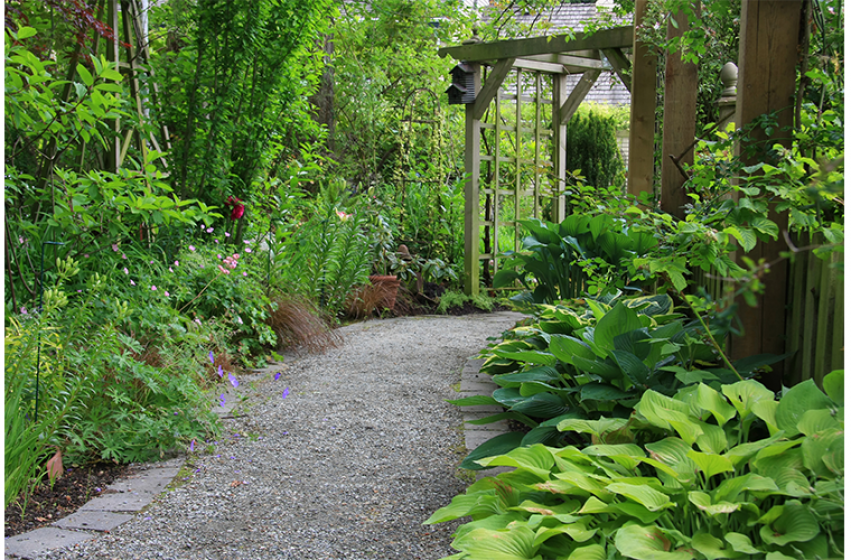Struggling to find plants for those shady spots? No worries! Shade offers the opportunity to grow some wonderful, unique plants that not only tolerate lack of sun but actually prefer it. Large trees and shady areas in your yard can present a challenge to even the most creative gardener, but growing in the shade doesn’t have to be frustrating. Liven up your shady spaces with these shade-loving annuals, perennials, trees and shrubs that can be enjoyed year-round.
WHAT IS SHADE? NOT ALL SHADE IS CREATED EQUAL
Partial shade - three to four hours of sun exposure each day, preferably during the cooler hours of the morning and early afternoon.
Filtered or dappled sunlight - similar to partial shade. Sun that makes its way through the branches of a tree (or trees). Sunlight passes through the tree canopy and the leaves create a pattern of light and shadow, or dappled sunlight.
Full or deep shade - less than two to three hours of direct sunlight each day with filtered sunlight the rest of the day, such as at the base of a north-facing wall or below dense evergreen trees.
TIP: The east side of homes typically receive morning sun with shade in the afternoon. The northern side generally receive very little light.
PLANNING YOUR SHADE GARDEN
When planning your shade garden, we recommend that you create an overhead drawing that includes your garden’s specific dimensions. It’s also helpful to mark both north and south on your drawing to help access lighting conditions, which will help to determine what types of plants will work best. Bring your plan in to any of our year-round locations and let one of our experts get you started on creating a beautiful and successful shade garden. Before buying plants, assess your garden for light and know the amount of sun your garden receives. How dense is the shade? What time of day do you get sun? Is it milder morning sun or stronger afternoon sun? Also take into account the type of soil you have- wet or dry, clay or sand, etc. Consider these other design elements and features when planning your shade garden:
- Color - brighten-up shady spaces by incorporating an assortment of colorful flowering plants or use a single color to define a chosen color theme.
- Focus on foliage texture and color. Blend different foliage shapes, textures and colors. Interesting foliage will add drama and dimension and provide a beautiful backdrop for flowers.
- Layering - will help move your eye through the landscape. Place taller plants in the back with smaller, shorter plants in front.
- Plant is mass - group several of the same plant or several plants that have similar color, texture, and density together. Use groups in odd numbers (3, 5, etc.).
- Curved/sweeping lines - sweeping curves and meandering bed lines introduce a sense of movement and help guide the eye through the design.
- Water - add a fountain or bird bath to reflect light, create movement and add sound.
- Walkway - provides a safe and easy walkway in and out of the garden and helps to visually connect your garden and home. Use materials like mulch, pavers or rock to create pathways.
- Statuary - incorporating a piece of statuary is a great way to add a focal point to your outdoor space.
- Lighting - lighting can help draw attention and illuminate shady areas in the late afternoon and into the evening.
TIP: Use white or light-colored flowers and variegated foliage plants. Whites, pale, creamy yellows, and light colors pop out in the shade. If you want to use darker colors, back them with variegated foliage or lighter colored flowers.
TREES THAT CREATE SHADE:
Large trees - those that grow to 30 to 50 feet high.
willow oaks • maples (October Glory) • river birch • zelcobas
Understory trees - those that are small enough and are shade tolerant to thrive under the canopies of other taller trees.
crepe myrtles • cherries • ornamental trees (pear)
TREES FOR SHADE
dogwoods • redbuds • Japanese maples
SHRUBS FOR SHADE
hydrangeas • azaleas • camellias • boxwood • fatsia • mahonia • gardenias • daphne • false yew • rhododendron
PERENNIALS FOR SHADE
ferns • hostas • heuchera • hellebores • carex • acorus • peonies • leopard plant • acanthus • astilbe • cast iron
GROUNDCOVERS FOR SHADE
liriope • vinca • mondo grass • sedum ogon
VINES FOR SHADE
climbing hydrangeas • clematis • jasmine
HOUSEPLANTS FOR SHADE Most all tropical plants will do well in shade.
ferns • anthurium • cordyline • palms • croton • snake plants • philodendron
ANNUALS FOR SHADE
begonias • shrimp plant • coleus • impatiens
SHADE GARDEN DESIGN ACCESSORIES
Incorporating garden accessories into your design will add personality, beauty, and in some cases, functionality. Change the look and feel of your garden space easily by rotating or swapping out accessories seasonally. Larger garden elements such as gazebos, arbors, patio furniture or ornamental stones can provide a focal point in your garden. Plan these elements carefully, since they are harder to relocate than smaller elements like potted plants, birdbaths and houses.
To learn more about shade plants click here.
To view the video on "How to Create a Shade Garden" click here.

